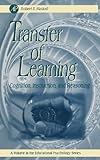The test had about 8 problems (out of 27) that are amenable to memorizing algebraic transformations or definitions. So "teaching to the test" as you describe it is a great way to make sure your students get a solid 30%.
To the point that it is known that US math tests tend to eschew even word problems [2] to a great degree.
There are about 8/27 word problems. The rest are geometric reasoning problems along the lines of the German test you link to (I don't read German so I can't compare except in general terms).
Incidentally, transfer of learning is pretty much nonexistent. Wish I had an online source, but all I have to link to is a dead tree: http://www.amazon.com/Transfer-Learning-Instruction-Educatio...
Incidentally, I'm really glad someone is actually engaging with the topic rather than just reciting memorized talking points. Reminds me of what hacker news used to be like.


There is extensive evidence of a sheepskin effect, and most studies of educational effectiveness are consistent with signalling theories and ability bias (more able individuals get educated).
https://www.nas.org/articles/The_Sheepskin_Effect
There is likely to be some benefit to education, but it's far less than what politicians currently believe and what current policies are predicated on.